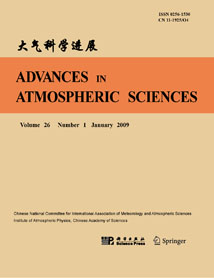| [1] |
CHEN Hua, GUO Jing, XIONG Wei, GUO Shenglian, Chong-Yu XU,
2010: Downscaling GCMs Using the Smooth Support Vector Machine Method to Predict Daily Precipitation in the Hanjiang Basin, ADVANCES IN ATMOSPHERIC SCIENCES, 27, 274-284.
doi: 10.1007/s00376-009-8071-1
|
| [2] |
FANG Changfang*, WU Lixin, and ZHANG Xiang,
2014: The Impact of Global Warming on the Pacific Decadal Oscillation and the Possible Mechanism, ADVANCES IN ATMOSPHERIC SCIENCES, 31, 118-130.
doi: 10.1007/s00376-013-2260-7
|
| [3] |
LIU Chengyan* and WANG Zhaomin, ,
2014: On the Response of the Global Subduction Rate to Global Warming in Coupled Climate Models, ADVANCES IN ATMOSPHERIC SCIENCES, 31, 211-218.
doi: 10.1007/s00376-013-2323-9
|
| [4] |
Xiaohan LI, Yi ZHANG, Yanluan LIN, Xindong PENG, Baiquan ZHOU, Panmao ZHAI, Jian LI,
2023: Impact of Revised Trigger and Closure of the Double-Plume Convective Parameterization on Precipitation Simulations over East Asia, ADVANCES IN ATMOSPHERIC SCIENCES, 40, 1225-1243.
doi: 10.1007/s00376-022-2225-9
|
| [5] |
JIE Weihua, WU Tongwen, WANG Jun, LI Weijing, LIU Xiangwen,
2014: Improvement of 6-15 Day Precipitation Forecasts Using a Time-Lagged Ensemble Method, ADVANCES IN ATMOSPHERIC SCIENCES, 31, 293-304.
doi: 10.1007/s00376-013-3037-8
|
| [6] |
LIU Ge, WU Renguang, ZHANG Yuanzhi, and NAN Sulan,
2014: The Summer Snow Cover Anomaly over the Tibetan Plateau and Its Association with Simultaneous Precipitation over the Mei-yu-Baiu region, ADVANCES IN ATMOSPHERIC SCIENCES, 31, 755-764.
doi: 10.1007/s00376-013-3183-z
|
| [7] |
Yuan WANG,
2015: Air Pollution or Global Warming: Attribution of Extreme Precipitation Changes in Eastern China——Comments on "Trends of Extreme Precipitation in Eastern China and Their Possible Causes", ADVANCES IN ATMOSPHERIC SCIENCES, 32, 1444-1446.
doi: 10.1007/s00376-015-5109-4
|
| [8] |
Shuangmei MA, Congwen ZHU, Juan LIU,
2020: Combined Impacts of Warm Central Equatorial Pacific Sea Surface Temperatures and Anthropogenic Warming on the 2019 Severe Drought in East China, ADVANCES IN ATMOSPHERIC SCIENCES, 37, 1149-1163.
doi: 10.1007/s00376-020-0077-8
|
| [9] |
JIA Xiaolong, LI Chongyin, LING Jian, Chidong ZHANG,
2008: Impacts of a GCM's Resolution on MJO Simulation, ADVANCES IN ATMOSPHERIC SCIENCES, 25, 139-156.
doi: 10.1007/s00376-008-0139-9
|
| [10] |
Donglin GUO, Huijun WANG,
2016: Comparison of a Very-fine-resolution GCM with RCM Dynamical Downscaling in Simulating Climate in China, ADVANCES IN ATMOSPHERIC SCIENCES, 33, 559-570.
doi: 10.1007/s00376-015-5147-y
|
| [11] |
WANG Xinmin, ZHAI Panmao, WANG Cuicui,
2009: Variations in Extratropical Cyclone Activity in Northern East Asia, ADVANCES IN ATMOSPHERIC SCIENCES, 26, 471-479.
doi: 10.1007/s00376-009-0471-8
|
| [12] |
Wang Zifa, Huang Meiyuan, He Dongyang, Xu Huaying, Zhou Ling,
1996: Sulfur Distribution and Transport Studies in East Asia Using Eulerian Model, ADVANCES IN ATMOSPHERIC SCIENCES, 13, 399-409.
doi: 10.1007/BF02656856
|
| [13] |
XU Ying, GAO Xuejie, F. GIORGI,
2009: Regional Variability of Climate Change Hot-spots in East Asia, ADVANCES IN ATMOSPHERIC SCIENCES, 26, 783-792.
doi: 10.1007/s00376-009-9034-2
|
| [14] |
LI Jiawei, HAN Zhiwei,
2012: A Modeling Study of Seasonal Variation of Atmospheric Aerosols over East Asia, ADVANCES IN ATMOSPHERIC SCIENCES, 29, 101-117.
doi: 10.1007/s00376-011-0234-1
|
| [15] |
Zhenxi ZHANG, Wen ZHOU, Mark WENIG, Liangui YANG,
2017: Impact of Long-range Desert Dust Transport on Hydrometeor Formation over Coastal East Asia, ADVANCES IN ATMOSPHERIC SCIENCES, 34, 101-115.
doi: 10.1007/s00376-016-6157-0
|
| [16] |
Fei WANG, Hua ZHANG, Qi CHEN, Min ZHAO, Ting YOU,
2020: Analysis of Short-term Cloud Feedback in East Asia Using Cloud Radiative Kernels, ADVANCES IN ATMOSPHERIC SCIENCES, 37, 1007-1018.
doi: 10.1007/s00376-020-9281-9
|
| [17] |
Sining LING, Riyu LU, Hao LIU, Yali YANG,
2023: Interannual Meridional Displacement of the Upper-Tropospheric Westerly Jet over Western East Asia in Summer, ADVANCES IN ATMOSPHERIC SCIENCES, 40, 1298-1308.
doi: 10.1007/s00376-022-2279-8
|
| [18] |
Yan HUANG, William L. CHAMEIDES, Qian TAN, Robert E. DICKINSON,
2008: Characteristics of Anthropogenic Sulfate and Carbonaceous Aerosols over East Asia: Regional Modeling and Observation, ADVANCES IN ATMOSPHERIC SCIENCES, 25, 946-959.
doi: 10.1007/s00376-008-0946-z
|
| [19] |
GAO Lijie, ZHANG Meigen, HAN Zhiwei,
2009: Model Analysis of Seasonal Variations in Tropospheric Ozone and Carbon Monoxide over East Asia, ADVANCES IN ATMOSPHERIC SCIENCES, 26, 312-318.
doi: 10.1007/s00376-009-0312-9
|
| [20] |
LIU Qianxia, ZHANG Meigen, WANG Bin,
2005: Simulation of Tropospheric Ozone with MOZART-2:An Evaluation Study over East Asia, ADVANCES IN ATMOSPHERIC SCIENCES, 22, 585-594.
doi: 10.1007/BF02918490
|















 AAS Website
AAS Website 
 AAS WeChat
AAS WeChat 
 DownLoad:
DownLoad: